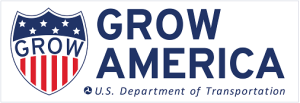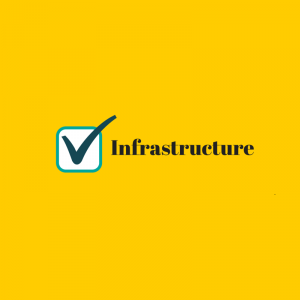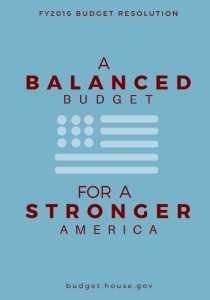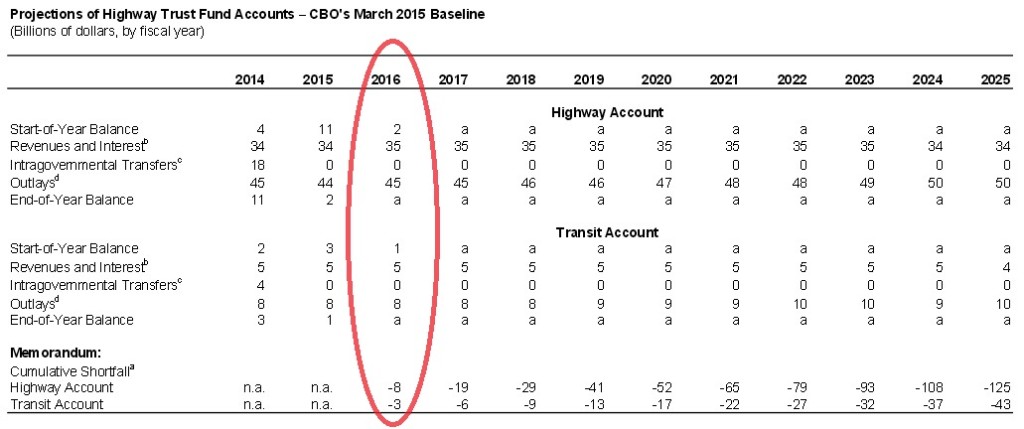It's Time Again to GROW America
April 1st, 2015 | By: America's Infrastructure Report Card
 During a recent interview with Politico’s Mike Allen, U.S. Secretary of Transportation Anthony Foxx noted that the nation’s transportation system is “in a huge ditch.” Yesterday, the U.S. Department of Transportation (USDOT) unveiled its idea on how to get America out of that ditch with their GROW America proposal. If the name sounds familiar, it’s because that was the original title of the previous federal surface transportation program proposal unveiled by the Obama Administration last year. The key difference this year is that the Administration has identified a specific funding source, taxing overseas corporate profits, to pay for the $478 billion, six-year bill.
The GROW America proposal, among other things, would:
• Increase the nation’s overall investment in transportation by 45%, with a 29% increase in highway spending and a 76% increase in transit spending;
• Provide $18 billion for a multi-modal freight program that strengthens America’s exports and trade;
• Include $28.6 billion for passenger rail programs;
• Double funding for the TIGER competitive discretionary grant program and create a new $6 billion highway and transit competitive grant program; and
• Double the Transportation Infrastructure Finance and Innovation Act (TIFIA) program which encourages utilization of innovative financing mechanisms.
USDOT published a state-by-state impact of the benefits of GROW America investment which included ASCE Report Card data on state needs and economic impacts. The GROW America Act is an important legislative marker that seeks to define the debate about the need to increase federal infrastructure investment in order to meet current and future capacity and maintenance challenges. Funding certainty is important to states for delivering projects, as the six-year time frame supports, but of additional importance is the need to increase overall federal funding. The current revenue rates have not risen since 1993 and since that time the cost to deliver projects has increased. Since 1993, in real terms, the average federal highway dollar has lost over a third of its purchasing power. Please urge your members of Congress to act now to grow the federal surface transportation program and fix the Highway Trust Fund.
During a recent interview with Politico’s Mike Allen, U.S. Secretary of Transportation Anthony Foxx noted that the nation’s transportation system is “in a huge ditch.” Yesterday, the U.S. Department of Transportation (USDOT) unveiled its idea on how to get America out of that ditch with their GROW America proposal. If the name sounds familiar, it’s because that was the original title of the previous federal surface transportation program proposal unveiled by the Obama Administration last year. The key difference this year is that the Administration has identified a specific funding source, taxing overseas corporate profits, to pay for the $478 billion, six-year bill.
The GROW America proposal, among other things, would:
• Increase the nation’s overall investment in transportation by 45%, with a 29% increase in highway spending and a 76% increase in transit spending;
• Provide $18 billion for a multi-modal freight program that strengthens America’s exports and trade;
• Include $28.6 billion for passenger rail programs;
• Double funding for the TIGER competitive discretionary grant program and create a new $6 billion highway and transit competitive grant program; and
• Double the Transportation Infrastructure Finance and Innovation Act (TIFIA) program which encourages utilization of innovative financing mechanisms.
USDOT published a state-by-state impact of the benefits of GROW America investment which included ASCE Report Card data on state needs and economic impacts. The GROW America Act is an important legislative marker that seeks to define the debate about the need to increase federal infrastructure investment in order to meet current and future capacity and maintenance challenges. Funding certainty is important to states for delivering projects, as the six-year time frame supports, but of additional importance is the need to increase overall federal funding. The current revenue rates have not risen since 1993 and since that time the cost to deliver projects has increased. Since 1993, in real terms, the average federal highway dollar has lost over a third of its purchasing power. Please urge your members of Congress to act now to grow the federal surface transportation program and fix the Highway Trust Fund.
Tags: congress, highway trust fund, infrastructure, report card, transportation
No Comments »
Budgets Represent Priorities
March 19th, 2015 | By: America's Infrastructure Report Card
This week the U.S. House of Representatives and the U.S. Senate majorities unveiled their fiscal year 2016 (FY16) budgets. Traditionally, passing a budget in Congress is a particularly partisan endeavor with most all members in the majority voting in favor of their budget, and all the minority members voting against it. Should this Congress pass a budget in the coming weeks, it will not have to go to President Obama for his signature as budgets are self-imposed restrictions on Congressional spending. However, occasionally Congress has increased funding levels for certain programs despite the budget instructing them not to do so. These proposals offer some insight into what transportation funding levels might look like in the coming year. Disappointing for transportation was that both the House and Senate budgets assumed that road, bridge and transit spending would be limited to incoming revenues to the federal Highway Trust Fund (HTF). This is a problem as the HTF has been facing fiscal pressure over the years and is forecast to require $13 billion in additional revenues in FY16 just to maintain current spending levels. Which is why ASCE supported a House Budget Committee amendment by Congresswoman Kathy Castor (D-FL) that would have maintained current spending levels for surface transportation. Unfortunately, the amendment failed in committee by a vote of 14-22. Better for transportation in the House and Senate budgets is the creation of what is known as a “reserve fund” for the HTF, which would allow the tax committees to determine how best to fill the trust fund hole in a way that is deficit-neutral. These ways could include raising taxes (including the federal gasoline tax), cutting spending, or transferring other government funds to transportation. ASCE called for and supported the creation of this HTF reserve fund, however in order to increase spending for other infrastructure sectors, like water, dams and levees, a broader Infrastructure Reserve Fund is also needed. Senate Budget Committee Ranking Member Bernie Sanders (I-VT) introduced such an amendment in committee, which ASCE supported, but unfortunately that too was defeated on a party-line vote. Earlier this year, ASCE endorsed legislation introduced by Senator Sanders that would increase funding for our nation’s transportation, water and other infrastructure sectors. The Senator is expected to offer other infrastructure-related amendments on the Senate floor when the budget is up for a vote there next week. The debate over the last few days on the budget has crystallized one key fact on transportation spending: the vast majority in Congress believe that we should be investing more in transportation but there is not yet widespread bipartisan consensus on exactly how to pay for it. ASCE needs your help to tell Congress to work quickly to identify a long-term, sustainable funding solution that would #FixTheTrustFund before the legislative deadline of May 31, 2015.Tags: congress, highway trust fund, infrastructure, transportation, water infrastructure
No Comments »
Action to Fix Highway Trust Fund Needed by This Summer
March 9th, 2015 | By: America's Infrastructure Report Card
Tags: bridges, highway trust fund, infrastructure, roads, transit, transportation
No Comments »
2015 Report Card for Iowa’s Infrastructure Arrives Next Tuesday
February 19th, 2015 | By: Infrastructure Report Card
The Iowa Section of the American Society of Civil Engineers (ASCE) will release the inaugural 2015 Report Card for Iowa’s Infrastructure on Tuesday, February 24. The report includes evaluations of Iowa aviation, rail, inland waterways, roads, bridges, dams, levees, drinking water, wastewater, electrical energy, and solid waste.News conference on release of the 2015 Report Card for Iowa’s Infrastructure
WHO: American Society of Civil Engineers – Iowa Section
Speakers:
- Joe Spradling, P.E., president, Iowa Section ASCE
- Aaron Granquist, P.E., author and member, Report Card Committee
- Director Debi Durham, Iowa Economic Development Authority
WHEN: Tuesday, February 24, 2015 at 10:30 am
WHERE: Wallace Building Auditorium, 502 E 9th Street, Des Moines, Iowa
Tags: bridges, economy, infrastructure, Iowa, report card, roads, transportation, water
No Comments »
USDOT Proposes We Move Beyond Traffic
February 3rd, 2015 | By: Becky Moylan
With the frequency of short-term funding and authorization patches for the Highway Trust Fund lately, it may seem that a long-term outlook for our transportation system is not top-of-mind. However, the U.S. Department of Transportation yesterday started a conversation to get Americans talking about where our transportation network should go in the next 30 years. The Secretary of Transportation, Anthony Foxx, joined Google’s Eric Schmidt for a Google Talk to discuss these challenges and opportunities. Watch the full conversation, which includes questions ranging from pedestrian safety to high-speed rail. Sec. Foxx also introduced the draft of Beyond Traffic: A Blue Paper, which is now available for review and open for comments. During the drafting process, ASCE members shared their ideas during visioning workshops. The blue paper identifies three strategies to decrease traffic and enhance our transportation system. Sec. Foxx shares them in his letter to the reader (p.iii-vi):- Take better care of America’s legacy transportation systems
- Build what is new and necessary, while considering how it can adapt in the future
- Use technologies and better design approaches that will maximize our old and new transportation assets
Tags: Airports, highway trust fund, Mass Transit, ports, rail transportation, transportation
No Comments »
Obama Budget Goes Big on Infrastructure
February 2nd, 2015 | By: America's Infrastructure Report Card

Photo of the cover of President Obama’s FY16 Budget; photo credit: Twitter image via Jonathan Weisman, The New York Times economic policy reporter
Tags: energy, highway trust fund, infrastructure, transportation, water
1 Comment »
Senator’s 2020 Vision For America’s Infrastructure
January 27th, 2015 | By: Becky Moylan
Aging infrastructure, graded at a D+ national GPA, is no secret. In fact, it is the news each and every day. From a water main break that hindered a morning commute in DC, to the potholes that inhibit safe driving, Americans across the country are experiencing inconveniences and challenges because of deficient roads, bridges, water pipes and other infrastructure. Furthermore, we have an investment shortfall across our major infrastructure sectors of just over $200 billion a year. Underinvesting in these vital systems costs us more in the long run. Today, Sen. Sanders shared his bill as a vision to better fund infrastructure and address the backlog of needs. As the new ranking member of the Senate Budget Committee, Sen. Sanders is taking the opportunity to introduce a $1 trillion, five-year plan for the nation’s infrastructure. The measure would inject an additional $75 billion a year into the Highway Trust Fund, create a national infrastructure bank and expand financing and grant programs. Additionally, it would fund freight and passenger rail improvements, airports, water projects, ports and inland waterways and national parks, along with broadband and electric networks. ASCE’s Casey Dinges joined the Senator from Vermont to share our vision of what needs to happen to improve our nation’s infrastructure. During his remarks, Casey said “By taking steps to invest in our nation’s infrastructure, the U.S. can protect $3.1 trillion in GDP, $1.1 trillion in U.S. trade value and 3.5 million jobs and a little over $3,000 a year per family. Without these investments, infrastructure – the backbone of our nation’s economy – will continue to decline and Americans will pay the price.” With the need to #FixTheTrustFund looming ahead, this bill is a positive step in the conversation and a good reminder that inaction is not an option.Tags: #fixthetrustfund, aviation, bridges, report card, roads, transportation
3 Comments »
Higher Gas Taxes Will Help Michigan Build a 21st Century Infrastructure
December 4th, 2014 | By: Maria Matthews
In 1997, Dolly was cloned, we were excited by the release of IE 4, and ASCE hadn’t yet released its first Report Card for America’s Infrastructure. It is also the last time Michigan increased its gas tax to the current 19-cents per gallon. The diesel tax rate has been in effect since 1984. The time is now for the state legislature to take action. HB 5477 was approved by the Michigan Senate on November 13th. It’s now the Michigan House’s turn to send this measure to the Governor’s desk. This bill will gradually increase the fuel tax to 15.5% through 2018. Governor Rick Snyder (R) has been actively urging the legislature to send him an infrastructure funding bill. The 2009 Michigan Report Card gave the state’s roads and bridges a “D” grade. While this might be within range of the national average, roads in poor conditions cost the average Michigander about $538.96 in extra vehicle repairs and general operating costs. This is an almost 10% increase since the 2009 assessment. If enacted, drivers will see a gradual increase in the state gas tax over the next four years, which results in additional road and transportation project funding. Michigan needs the additional tax revenue to maintain and improve its roads. Signing this transportation bill into law would also:- The initial 3.5% increase to 9.5% per gallon could result in an immediate $205 million in additional revenue. When the tax is in full effect in January 2019 an estimated $1.25 billion in revenue will be generated.
- The tax will be calculated based on a flat rate of $2.81 over the next several years rather than being fixed to the consumer price index. This will help ensure a more steady increase in revenue, at 2% per year for 3 years, through 2019.
- Anticipated revenue will be allocated to the Michigan Transportation Fund (MTF) and should only be available to for use on transportation related projects.
Tags: gas tax, roads, transportation
No Comments »
Election Results Signify Shift in Americans' Willingness to Invest in Infrastructure
November 7th, 2014 | By: Olivia Wolfertz
In light of the recent elections, infrastructure investment has now moved from a topic of discussion into a plan for action in many states. With the nation’s pressing infrastructure needs and limited federal funds available, ASCE is pleased that many states are finding creative ways to pay for infrastructure improvements through other means. With six states successfully passing ballots to fund infrastructure, it’s clear that many Americans are tired of underinvestment and want to see initiatives to improve infrastructure in their communities. In Maryland and Wisconsin, voters approved a transportation “lockbox” to secure funds for infrastructure needs. In Texas, oil and gas taxes will be used as a source for transportation funding. Rhode Island passed an initiative allowing the sale of bonds to fund renovations to mass transit and California passed an initiative that will improve water security for the state. Even in Michigan, where there was no infrastructure-related ballot initiative, Governor Rick Snyder announced his plan to raise at least $1 billion in new revenues for road repairs through fuel taxes and fees before the end of the year. Joseph Kane, a researcher with the Metropolitan Policy Program said, “The public sees the impact of transportation on their lives every day and so the attention this issue is receiving at the ballot box shows their growing awareness of problems.” Though several states are making proactive strides to improve infrastructure through investment, not all states are willing to take these steps. Massachusetts voters repealed gas tax indexing, which would have provided critical funding for transportation in the state. Louisiana also rejected a ballot initiative which would have created an infrastructure bank. ASCE President, Bob Stevens, Ph.D., P.E., said, “By failing to increase revenue or protect funding, these states are continuing with the status-quo, which is unacceptable. Leaders at all levels of government are now tasked with finding solutions to the infrastructure deficit.” Ballot measures to improve state infrastructure are steps in the right direction but are not enough without long-term, sustainable funding at the federal level. Voters demonstrated they want more investment in infrastructure. Now it’s time for Congress to respond to that plea and #FixtheTrustFund.Tags: 2014BallotInitiatives, infrastructure, transportation, water
No Comments »
Big Wins for Infrastructure on Election Day
November 5th, 2014 | By: Maria Matthews
 Leading up to yesterday’s election ASCE brought you information on many statewide ballot measures. ASCE staff worked with our dedicated members on the ground in California, Hawaii, Louisiana, Maryland, Massachusetts, Rhode Island, Texas, and Wisconsin. The issues being put to the test ranged from roads to water and addressed improvements to aging structures, compliance with safety ordinances, or preventing the diversion of dedicated revenue.
Now that ballots have been counted, infrastructure has emerged victorious in six of eight states. California, Hawaii, Maryland, Rhode Island, Texas, and Wisconsin, all overwhelmingly voted to take steps forward in addressing their state’s needs.
A win for infrastructure is a win for the residents and businesses in the state. Whether it’s improvements to the water system, mass transit investment or designating dedicated road funding, everyone benefits from well-maintained infrastructure.
Maryland and Wisconsin voters have successfully prevented their Trust Funds from being raided for general use while Texas established an infrastructure funding that will draw from oil and gas taxes as well as borrow from “rainy day” coffers. Commuting should soon be a bit easier in Rhode Island as a significant investment in mass transit will now be made with the hopes of alleviating congestion and improving accessibility. Investing in improvements to transportation and transit infrastructure benefits both individuals and businesses as it makes travelling safer, moving goods easier, and extends the utility of existing infrastructure.
Hawaii Dam and Reservoir owners will benefit from the ability to request financial assistance as they maintain and repair structures to ensure compliance with Hawaii’s safety standards. Californians can now be better prepared for the extreme drought conditions they’re currently experiencing by investing in projects that will improve water storage and reclamation, and also improve quality and access to clean water in certain parts of the state.
In other states, increasing the investment in infrastructure was unsuccessful. Voters in Louisiana and Massachusetts chose to continue with the status quo; the lack of serious investment in aging infrastructure could end up costing the state and its residents more in the long run. Poor road conditions, like those that exist in Louisiana, are not only costly to repair but, are also burdensome to commuters as it wears on their car. A little bit of investment now could mean a significant amount of savings in the long run. Massachusetts voters opted not to ensure a steady revenue stream for the maintenance of and improvement to state bridges and roads by repealing their gas tax’s link to the consumer price index.
Pass or fail, we hope that Tuesday’s results will bring renewed interest during the 2015 state legislative session in building and maintaining infrastructure systems that reflect the growing needs of residents and its economy. Ideally this momentum will also carry through to our nation’s capital and lead Congress to #FixtheTrustFund and address other sectors of our infrastructure in critical need of attention. Join us on Thursday, November 13, 2014 for a free eLearning Webinar What Civil Engineers Need to Know About 2014 Elections, which will further dive into this topic.
Leading up to yesterday’s election ASCE brought you information on many statewide ballot measures. ASCE staff worked with our dedicated members on the ground in California, Hawaii, Louisiana, Maryland, Massachusetts, Rhode Island, Texas, and Wisconsin. The issues being put to the test ranged from roads to water and addressed improvements to aging structures, compliance with safety ordinances, or preventing the diversion of dedicated revenue.
Now that ballots have been counted, infrastructure has emerged victorious in six of eight states. California, Hawaii, Maryland, Rhode Island, Texas, and Wisconsin, all overwhelmingly voted to take steps forward in addressing their state’s needs.
A win for infrastructure is a win for the residents and businesses in the state. Whether it’s improvements to the water system, mass transit investment or designating dedicated road funding, everyone benefits from well-maintained infrastructure.
Maryland and Wisconsin voters have successfully prevented their Trust Funds from being raided for general use while Texas established an infrastructure funding that will draw from oil and gas taxes as well as borrow from “rainy day” coffers. Commuting should soon be a bit easier in Rhode Island as a significant investment in mass transit will now be made with the hopes of alleviating congestion and improving accessibility. Investing in improvements to transportation and transit infrastructure benefits both individuals and businesses as it makes travelling safer, moving goods easier, and extends the utility of existing infrastructure.
Hawaii Dam and Reservoir owners will benefit from the ability to request financial assistance as they maintain and repair structures to ensure compliance with Hawaii’s safety standards. Californians can now be better prepared for the extreme drought conditions they’re currently experiencing by investing in projects that will improve water storage and reclamation, and also improve quality and access to clean water in certain parts of the state.
In other states, increasing the investment in infrastructure was unsuccessful. Voters in Louisiana and Massachusetts chose to continue with the status quo; the lack of serious investment in aging infrastructure could end up costing the state and its residents more in the long run. Poor road conditions, like those that exist in Louisiana, are not only costly to repair but, are also burdensome to commuters as it wears on their car. A little bit of investment now could mean a significant amount of savings in the long run. Massachusetts voters opted not to ensure a steady revenue stream for the maintenance of and improvement to state bridges and roads by repealing their gas tax’s link to the consumer price index.
Pass or fail, we hope that Tuesday’s results will bring renewed interest during the 2015 state legislative session in building and maintaining infrastructure systems that reflect the growing needs of residents and its economy. Ideally this momentum will also carry through to our nation’s capital and lead Congress to #FixtheTrustFund and address other sectors of our infrastructure in critical need of attention. Join us on Thursday, November 13, 2014 for a free eLearning Webinar What Civil Engineers Need to Know About 2014 Elections, which will further dive into this topic.
Tags: 2014BallotInitiatives, infrastructure, transportation, water
No Comments »



 */ ?>
*/ ?>













